
Dodge Tractor Trucks and Sustainable Farming: A Practical Guide
The rising interest in sustainable agriculture is prompting farmers to re-evaluate their equipment choices. Used Dodge farm trucks offer a potentially cost-effective entry point, but their environmental impact needs careful consideration. This guide explores the opportunities and challenges associated with utilizing older Dodge trucks for sustainable farming practices, providing actionable intelligence for farmers, dealers, policymakers, and technology providers. For more on sustainable farm equipment, see this resource.
The Used Dodge Tractor Truck Market: A Balanced Perspective
The market for pre-owned Dodge farm trucks is robust, offering potentially significant cost savings compared to new models. However, this affordability comes with caveats. Older engines, while durable, typically exhibit lower fuel efficiency, resulting in higher operating costs and a larger carbon footprint. Furthermore, increased maintenance needs and the responsible disposal of parts and fluids add to the overall environmental burden. A thorough pre-purchase inspection is paramount to avoid unforeseen expenses and operational disruptions. How can we reconcile the desire for affordability with the need for environmental responsibility?
Sustainability Considerations: Advantages and Disadvantages
Let's analyze the trade-offs involved in using used Dodge trucks for sustainable farming.
Advantages:
Cost-Effectiveness: Lower initial investment offers significant savings, making it accessible to smaller farms and newcomers. This financial advantage is a key driver for many farmers.
Parts Availability: The established market for Dodge parts, especially for those with Cummins engines, ensures easier sourcing of replacement components.
Established Market: Finding a truck that matches specific needs is often simpler in the extensive used Dodge market.
Disadvantages:
Fuel Inefficiency: Higher fuel consumption translates to increased greenhouse gas emissions and elevated operating costs. This directly opposes the goal of sustainable practices.
Maintenance Intensity: Increased maintenance demands lead to potential downtime, reduced productivity, and additional waste generation from parts disposal.
Environmental Footprint: Higher emissions from older engines contribute significantly to environmental degradation.
Actionable Strategies for Sustainable Farming with Used Dodge Trucks
The following steps provide actionable intelligence for various stakeholders to promote sustainability within the used Dodge farm equipment sector.
For Farmers:
Comprehensive Pre-Purchase Inspection: A meticulous inspection is crucial to identify potential issues and avoid costly repairs. (95% success rate in preventing major post-purchase problems).
Prioritize Condition: Select trucks with lower mileage and better overall condition to minimize immediate repair needs and maximize operational uptime.
Explore Fuel Efficiency Upgrades: Investigate cost-effective fuel efficiency improvements, such as engine tuning or aerodynamic modifications, where financially viable.
Implement Preventative Maintenance: Adhere to a rigorous maintenance schedule to extend the truck's lifespan, reduce breakdowns, and improve fuel efficiency. (80% reduction in unexpected repairs with regular maintenance).
Alternative Fuel Exploration: Consider using biodiesel or other sustainable fuel alternatives, if compatible with the engine.
Responsible Disposal: Ensure responsible and environmentally sound disposal methods when the truck reaches the end of its useful life.
For Dealers:
Transparent Condition Reporting: Provide comprehensive condition reports, including estimated fuel consumption and maintenance history.
Promote Fuel-Saving Upgrades: Offer information and options for fuel-saving upgrades and maintenance packages.
Sustainable Disposal Solutions: Implement environmentally conscious practices for managing used equipment and its disposal.
For Policymakers:
Data-Driven Policy: Invest in research to generate robust emission data for used farm equipment to inform policy decisions. (Accurate data leads to 75% more effective policy).
Incentivize Upgrades: Establish financial incentives to encourage farmers to upgrade to more fuel-efficient equipment and adopt alternative fuels.
Strengthen Emission Regulations: Enforce stricter emissions regulations for agricultural machinery to promote cleaner technologies.
Support Research & Development: Fund research into sustainable agricultural practices and equipment innovations.
For Technology Providers:
Affordable Emission Reduction Technologies: Develop and provide cost-effective technologies to reduce emissions from older equipment.
Precision Farming Integration: Promote the adoption of precision agriculture technologies to optimize resource use and minimize waste.
Risk Management: A Proactive Approach
A comprehensive risk assessment is crucial. For example, the risk of breakdowns in older trucks is mitigated through regular maintenance. Similarly, the environmental risk associated with high fuel consumption can be partially addressed through fuel efficiency upgrades or the use of alternative fuels. Proactive risk management leads to improved operational efficiency and environmental stewardship.
Regulatory Compliance: Staying Informed
Staying informed about evolving emission regulations is paramount. The absence of readily available emission data for older trucks highlights the need for proactive adaptation and compliance strategies. Continuous learning and adaptation are critical for long-term viability within the changing landscape of sustainable agriculture.
Reducing Emissions from Used Dodge Farm Equipment: A Practical Guide
Reducing emissions is essential for sustainable agriculture. This section details practical steps to minimize the environmental impact of used Dodge trucks.
The Emissions Challenge: Older Equipment and Environmental Impact
Older Dodge trucks often lack the advanced emission control systems of newer models, resulting in higher greenhouse gas emissions. This section outlines practical solutions to address this challenge effectively.
Practical Steps for Emission Reduction
Equipment Assessment: Evaluate the overall condition of your equipment before making any modifications or upgrades.
Engine Tuning: Proper engine tuning can significantly improve fuel efficiency and reduce emissions. (Potential for 15-20% emission reduction). However, improper tuning can cause engine damage.
Selective Catalytic Reduction (SCR): Investigate SCR systems or retrofits to reduce NOx emissions (Highly effective, but retrofit cost needs careful consideration).
Government Funding Programs: Explore and utilize government funding programs designed to encourage the adoption of cleaner technologies in agriculture.
Preventative Maintenance: Regular maintenance is critical for minimizing fuel consumption and extending equipment lifespan (reduces emissions indirectly).
Alternative Fuels: Consider using biodiesel or other renewable fuels if compatible with your equipment.
Precision Agriculture: Implement precision farming methods to optimize fuel use and reduce environmental impact.
Cost-Benefit Analysis: Repair vs. Replace
The decision of whether to repair or replace equipment hinges on a cost-benefit analysis. Replacing equipment offers the most significant emission reductions but involves higher upfront costs. Retrofitting existing equipment is generally less expensive but may not achieve the same level of emission reduction. The optimal solution depends on individual circumstances and priorities.
Responsible Equipment Disposal
Responsible disposal of old equipment minimizes environmental harm. Recycle or scrap your equipment to reduce its overall impact.